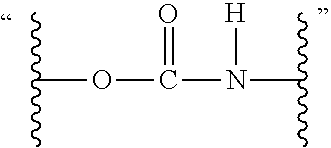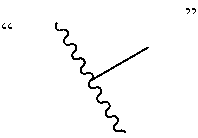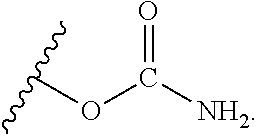Ambient temperature curable isocyanate-free compositions for preparing crosslinked polyurethanes
a technology of isocyanate-free compositions and crosslinked polyurethanes, which is applied in the field of crosslinked polyurethanes, can solve the problems of not revealing the preparation of crosslinked polyurethanes with active hydrogen-containing materials, affecting the environment and people exposed thereto, and preventing the use of isocyanate-free polyurethane preparations in certain adhesive applications requiring curing at ambient temperature, so as to achieve higher crosslinking levels and improve performance characteristics or properties
- Summary
- Abstract
- Description
- Claims
- Application Information
AI Technical Summary
Benefits of technology
Problems solved by technology
Method used
Image
Examples
preparation 1
[0164]Preparation of an approximately 1:1 mixture of 1,3- and 1,4-cyclohexanedicarboxaldehydes, (P1). Follows the procedure of Example 8 of U.S. Pat. No. 6,252,121. A solution of rhodium dicarbonyl acetylacetonate and tris(2,4-bis(1,1-dimethylethylphenyl)phosphite (i.e. Ligand C) in hexane (20 grams) containing 300 parts per million rhodium with Ligand C / rhodium molar ratio of 20 / 1 is placed in a Parr reactor and activated for about 1 hour at 90° C. and 100 psi of syngas (CO / H2, 1:1). Charge 1,2,3,6-tetrahydrobenzaldehyde (40 grams, prepared via a Diels Alder reaction 1,3-butadiene and acrolein) to the autoclave and hydroformylate at 90° C. and 100 psi of syngas. The CO / H2 ratio is maintained 1:1 during the course of reaction. The reaction is continued until gas chromatographic analysis shows complete consumption of 1,2,3,6-tetrahydrobenzaldehyde. The selectivity to 1,3- and 1,4-cyclohexanedicarboxaldehyde product is more than 95%. The autoclave is cooled to ambient temperature, and...
preparation 1a
[0165]Preparation of UNOXOL Diol initiated NOP, (P1a): Add 330.4 grams of methyl hydroxymethyl stearate, 72.4 grams of an approximately 1:1 mixture of 1,3 and 1,4-cyclohexanedimethanol (UNOXOL™ Diol), and 0.411 grams of dibutyltin oxide catalyst to a 500 milliliter five-neck round bottom glass flask equipped with a mechanical stirrer, condenser, addition funnel, nitrogen gas inlet, and a THERM-O-WATCHT™ sensor (Glas-Col, LLC, Terre Haute, Ind., USA) to monitor / control reaction temperature. Bring temperature of the mixture up to 150° C. with stirring using an external hot oil bath, and maintain at 150° C. for one hour. Then raise the temperature in 10° C. increments every 45 minutes until reaching a final reaction temperature of 200° C. Collect a total of 30 grams of methanol (90% of theoretical). Collect the resulting natural oil polyol (NOP) (P1a), which has a measured hydroxyl number of 136 mg KOH / g (P1a).
Preparation 1b
[0166]Preparation of 1,3 / 1,4-ADI trimer, (P1b):
[0167]
[0168]Pre...
preparation 2
[0170]Preparation of a Natural Oil dicarbamate, (P2): Into a system comprising a 3 necked 500 mL round bottom flask equipped with a mechanical stirrer, Dean-Stark trap, packed condenser (using glycol / water circulated at 65° C.), and a nitrogen gas bubbler system is placed the UNOXOL™ Diol initiated NOP (150 g, Preparation 1a), methyl carbamate (66.75 g), dibutyltin dilaurate (0.325 g), and toluene (25 mL) to give a reaction mixture. The system is flushed with nitrogen before heating. The reaction mixture is brought to 120° C. with a slow nitrogen sweep for 2 days, sampled periodically and analyzed for hydroxyl number until a hydroxyl number below 20 mg KOH / g is reached. Once the hydroxyl number below 20 mg KOH / g is reached, the packed condenser is replaced with a short path distillation head and nitrogen flow is increased to remove the toluene and any remaining methyl carbamate. The Natural Oil dicarbamate (P2) having a final hydroxyl number of 3.4 mg KOH / g (P2) is prepared.
PUM
| Property | Measurement | Unit |
|---|---|---|
| pH | aaaaa | aaaaa |
| temperature | aaaaa | aaaaa |
| temperature | aaaaa | aaaaa |
Abstract
Description
Claims
Application Information
 Login to View More
Login to View More - R&D
- Intellectual Property
- Life Sciences
- Materials
- Tech Scout
- Unparalleled Data Quality
- Higher Quality Content
- 60% Fewer Hallucinations
Browse by: Latest US Patents, China's latest patents, Technical Efficacy Thesaurus, Application Domain, Technology Topic, Popular Technical Reports.
© 2025 PatSnap. All rights reserved.Legal|Privacy policy|Modern Slavery Act Transparency Statement|Sitemap|About US| Contact US: help@patsnap.com



